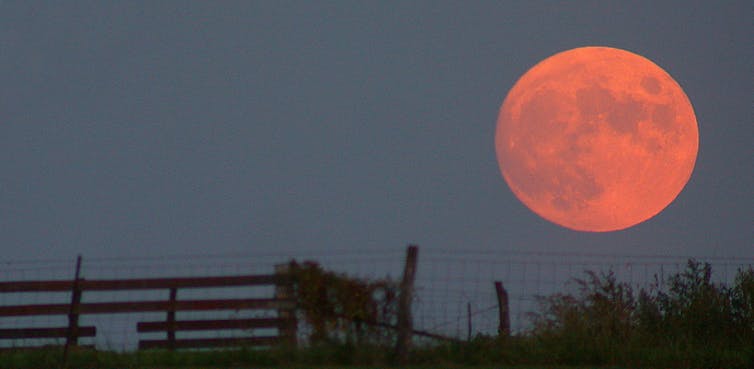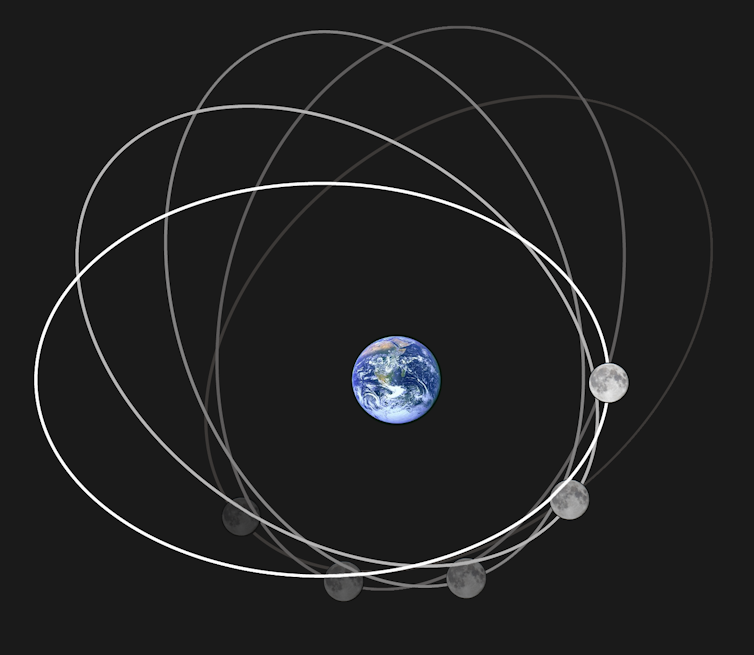

Curious Kids is a series for children of all ages. If you have a question you’d like an expert to answer, send it to This email address is being protected from spambots. You need JavaScript enabled to view it..
Why does the moon look close some nights and far away on other nights? – Gabriel H., age 7, Providence, Rhode Island
Some nights the Moon seems really close and bigger than usual.
One summer evening when I was a child, I remember being mystified and then startled at a huge round shape slowly creeping up behind my friend Nancy’s house, which sat on a hill on the other side of our village.
At some point I suddenly realized it was the Moon, and I ran yelling through the garden to tell my dad and get him to come and see. It was bigger than a house, deep orange in color and surely of great significance. My dad muttered something about perspective and went back to gardening or playing the piano.
Unconvinced, I kept watching the Moon. Later, once the Moon had risen higher in the sky, it was back to looking like its usual self.
Welcome to what astronomers like me call the Moon illusion.
It can be hard to believe that it is just an illusion when the Moon looks huge, but it is true. You can actually test the illusion yourself and even capture it with a camera.

A trick of the mind
Astronomers have discussed the Moon illusion for centuries, and there are some facts they all agree on.
People mainly notice the Moon looking bigger and closer when it is full and near the horizon. This is because your mind judges how big or small an object like the Moon is by comparing it with other, familiar things.
Imagine you are standing outside close to your house. Your house will look big, and if the Moon rises next to it, the Moon will look normal. If you look at a house from far away, though, the house looks very small.
The illusion comes from the fact that the Moon is so far away that no matter where you are on Earth, the Moon always looks the same size. It is actually the things your mind compares the Moon with – a house, a mountain or anything else – that look bigger or smaller depending on how far away from them you are. So when the Moon rises next to a distant house or a faraway mountain, the Moon looks enormous.

Photographers use this trick to take spectacular images of distant objects with the Moon behind them. People often experience the Moon illusion on vacations when they go to wide-open spaces. This may be why big Moons become powerful memories of happy times.
Atmospheric zoom and changing orbits
There are several convincing-sounding but wrong explanations for the Moon illusion. Most are grounded in some truth, so they persist.
First is the idea that the atmosphere acts like a lens and magnifies the Moon. When the Moon is near the horizon, its light has to travel though much more of the Earth’s atmosphere than when the Moon is directly overhead. It’s true that all that air acts like a giant prism and bends the rays of light, distorting the color and shape of the Moon. But it does not act like a magnifying glass.
Next is the idea that on some nights the Moon really is closer. The Moon’s orbit is not perfectly circular – it’s more like an oval shape, called an ellipse – so the Moon does get nearer and farther away over the course of a month.

When the close part of the orbit coincides with a full moon, it’s called a supermoon. But when the Moon is closest to Earth, it is only about 12% to 15% closer than when it is farthest from Earth – too small a difference to explain the Moon illusion. It is hard to notice a 15% difference in size by just looking at the Moon alone in the sky.
Testing the illusion
It’s easy to test the Moon illusion, and you can do it yourself. Next time you see the Moon looking huge and closer than usual, hold out your hand with a straight arm. Then close one eye and see which finger tip just barely covers the Moon – for me, it’s my pinkie finger. Wait a little while until the Moon moves higher into the sky and try the experiment again. The Moon may look smaller, but your same finger will cover it just the same.
Hello, curious kids! Do you have a question you’d like an expert to answer? Ask an adult to send your question to This email address is being protected from spambots. You need JavaScript enabled to view it.. Please tell us your name, age and the city where you live.
And since curiosity has no age limit – adults, let us know what you’re wondering, too. We won’t be able to answer every question, but we will do our best.![]()
Silas Laycock, Professor of Astronomy, UMass Lowell
This article is republished from The Conversation under a Creative Commons license. Read the original article.

